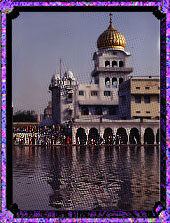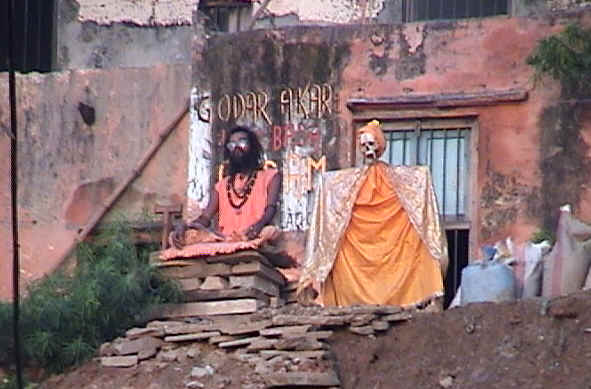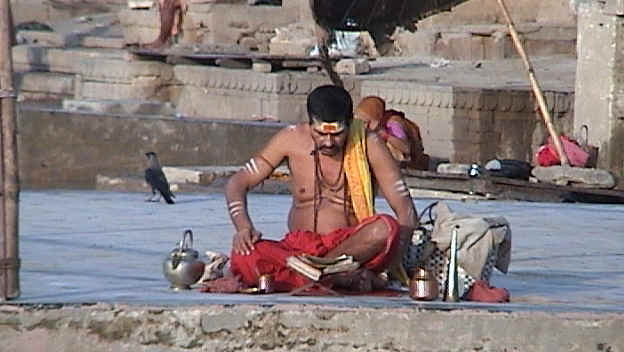| about
us |
our
world |
Spiritual Religious Tours
|
RELIGIONS IN INDIA As many countries encourage and breeds Capitalism, so India encourages and breeds Spiritualism. The people, the infrastructure, and indeed the earth allows religions to thrive, flourish and prosper. It is therefore not surprising to find not only the presence of all major religions in the world in India, but the presence of their many off-shoots and facets as well, all being supported and nourished, and all living in comparative harmony. Many of these were conceived in India, and others have come to India seeking a safe haven from persecution after they came into being in their own lands. Age-old environment has always supported such freedom of belief. We will thus find Judaism, Islam, The Bahá'í Faith, Christianity, Jainism, Zoroastrianism, Hinduism, Buddhism and Sikhism amoungst the major religions being practiced in India, together with a variety of The Lesser Known Religions Since religion is the most enduring bond and a preservative of social customs, architecture, diet, thought and way of life, you will consequently will find unparalleled discreet and different customs, architecture, diet, thought and way of life in India. Such a palette is nowhere to be found in any region in the world, let alone a single country as in India. If spiritualism is defined as either "having
something to do with the spirit or soul", an example being "an
outward and visible sign of an inward and spiritual grace given unto
us", or "caring much for things of the spirit or soul",
such as "men are they who see that spirituality is stronger than
any material force", or "having to do with spirits;
supernatural" such as "Millions of spiritual creatures walk
the earth unseen", then you will not just see, but experience,
feel, hear, smell and taste spiritualism in India. To take a snap-shot of India’s cultural heritage, keep in mind that apart from Hindi and English being the main languages of the country, there are an ADDITIONAL 17 languages recognized for official purposes: Assamese, Bengali, Gujarati, Kannada, Kashmiri, Konkani, Malayalam, Manipuri, Marathi, Nepali, Oriya, Punjabi, Sanskrit, Sindhi, Tamil, Telugu and Urdu - (just see an Indian bank note!). Judaism: Jews in India, such as the Bene-Israel (Hebrew: "Sons of Israel"), have lived for centuries in Bombay and adjacent regions, totally isolated from other Jewish influences. These settlers came as merchants in search of spices, sandalwood, cloves, ivory and precious stones. Some of these are descended from Jews who escaped persecution in Galilee in the 2nd century BC and were identified as "Black-Jews". There is very little reliable information about the origin of Kerala Jews. One belief is that 10 Jewish families released from jail by a Persian king in 605 BC came by ship to Kodungallore. Another group must have followed in 586 BC when Judea was defeated by Babylon. There were many subsequent waves of migration in 369 AD and most historians agree that the local Hindu rulers did everything to settle the new immigrants. India is perhaps one of the only countries in the world where there has never been any ant-Semitic sentiments expressed by the local communities. Jews continue to live and prosper in Western India, though with a population of only 6,000.Islam: Kerala, an Indian state on the Western coast of India, has had connections with Arabia from the time of Solomon. Arabs traded with Kerala for gold, ivory, monkeys and peacocks, with Arab merchants coming to Kerala from Egypt long before the Romans. It is thought that Islam entered India through Kerala in the 7th century AD soon after the religion was conceived by Mohammed (c 570 - 632 AD), in Arabia. But it was only in the 11th and 12th centuries that Muslim literary and cultural traditions recognized India as a place of refuge and gracious patronage, reaching the Indian heartland, and continued till the British strengthened their position in the 18th century. Today, Muslims are the second largest religious group with a population base of nearly 12%. Bahá'í Faith: Bahá'ís are from various parts of the world.
The Bahá'í Faith is the youngest of the world's independent
religions. The central theme of Bahá'u'lláh's message is that
humanity is one single race and that the day has come for its
unification in one global society. God, Bahá'u'lláh (1817-1892) (literally
the Glory of God), the founder, said, has set in motion historical
forces that are breaking down traditional barriers of race, class,
creed, and nation and that will, in time, give birth to a universal
civilization. The principal challenge facing the peoples of the earth
is to accept the fact of their oneness and to assist the processes of
unification. One of the purposes of the Bahá'í Faith is to help make
this possible. A worldwide community of some five million Bahá'ís,
representative of most of the nations, races and cultures on earth, is
working to give Bahá'u'lláh's teachings practical effect. The
history of the Bahá'í Faith in India started with the inception of
the Faith in Iran when Bahá’u’lláh appointed one of the Indian
believers as the 'Letter of Living' in 1844-45, the first year of His
Ministry. Since then, India is spiritually connected with the Bahá’i
Faith. Christianity: Trade between India and West Asia since ancient times was not only feasible, but common, and ports in the Western sea coast state of Kerela were well visited by such travelers. St. Thomas the Apostle arrived in Kodungalloor in Kerala on Nov. 21(?) 52 AD, and attempted to preach the Gospel to the Jews settled there. However, he was more successful in preaching to the Keralites and baptizing a number of high caste Hindus, including members from royal families, who formed the first Christian community in India. He then moved on to other kingdoms, probably reaching Sri Lanka, and returning to Madras in 72 AD where he was martyred that year. Indeed, the early Christians of India were known as Thomas Christians - until the advent of the Portuguese in the 16th century followed closely by the British. The arrival of St. Thomas was recognized by several writers from west Asia since 2nd century. The doctrine of the Apostle Thomas and the Acta Thomae, both of which are written at or near Edessa, circa 200-250 AD. St. Ephrem, St. John Chrisostom and St. Gregorios Nazianzen, in the 4th century, St. Jerome circa 400 AD, historian Eusabius circa 338 and Theodore of the 5th century attest to Apostle Thomas in India. History has it that His Grace Mar John, Archbishop of India, represented the Indian church in the Council of Nicea, in the year 325. In his signature to the decrees of the Council, he gives his title as "Prelate of Metropolitan of Persia and the Bishop of Great India". These Christians in India had no written records but an oral tradition handed down by their elders and to these they were most tenaciously attached. They lived under native princes who rarely interfered with their faith and one of the paramount Rajahs of Malabar, Cheruman Perumal, had conferred on them a special civilian status. Thus these Christians obtained status above the lower classes, and made them equal to the middle class in the country. The honorific appellation bestowed upon them by the rulers of the country is that of "Mapla", which signifies great son or great child, and they are commonly called ‘Mapla’ by the people even to this day. However, these St. Thomas Christians now prefer to be called the Nasrani (Nazarenes), the designation given by the Mohammedans to all Christians.Today, 2.5% of India's population are Christians, and Christianity is the third most populace religion in India.Jainism: Jainism was born in India about the same period as Buddhism, being established by Mahavira (c. 599 - 527 BC) who was born near Patna in what is now Bihar state. Mahavira was called ‘Jina’ meaning the big winner and from this name was derived the name of the religion. In many senses Jainism is similar to Buddhism. Both developed as a dissension to the Brahmanic philosophy that was dominant during that period in north-east India. Both share a belief in reincarnation which eventually leads to liberation. Jainism is different to Buddhism in its ascetic beliefs. Both these religions emphasize non-violence, but non-violence is the main core in Jainism.Jains believe that life breathes through every thing: stones, sand, trees etc. Mahavira who believed that every thing has life and also believed in non-violence nearly died due to self-induced starvation. After years of hardship and meditation he attained enlightenment; thereafter he preached Jainism for about 30 years and died at Pava (also in Bihar) in 527 BC. Mahavira was also extremely ascetic and walked around completely naked because of his renouncement of life. Currently, 0.5% of India's population are Jains. Zoroastrianism: Zoroastrianism is a small religious community, with its population base centered around Mumbai, established by Zarathustra in the 6th or 7th century BC. The followers are called Parsis because they came from Persia, now Iran, from where they were exiled in the 7th century AD because of religious persecutions by the Muslims. They traveled by sea, arriving in the coastal state of what is now called Gujarat in Western India. The Parsis believe in the existence of one invisible God. They believe that there is a continuous war between the good forces (forces of light), exemplified by good deeds, thought and speech and the evil forces (forces of darkness). God is represented in their temples through fire, which symbolizes light and believe that fire, water, air and earth are pure elements to be preserved. The holiest place for them is the village of Udvada in Gujarat, India. The Parsis are a close knit community numbering about 0.01% of India's population, however, they have contributed more to India than perhaps any other minority. Some Parsis were founders of the Indian Nationalist movement (for freedom from the British); they established modern Indian industry; they have been benevolent and have contributed enormously to establish charitable and such institutions in India, and they continue to oversee some of the bigger finance houses in India.Hinduism: Hindu mythology is rich, multifarious, and inclusive. It portrays the terrible alongside the benevolent, the trivial alongside the cosmic, and the grotesque alongside the sublime. The earliest source of Hindu mythology is the Vedic literature, the oldest texts of which are the four Vedas, or "Books of Knowledge": Rigveda, Yajurveda, Samaveda, and Atharvaveda. These books are the oldest Indian documents and represent the religion of the Aryan invaders of the subcontinent over the period from 1400 to 500 BC.
Buddhism: Buddhism came into being in northeastern India, during the period from the late 6th century to the early 4th century BC, a period of great social change and intense religious activity. There is disagreement among scholars about the dates of the Buddha's birth and death. Most scholars in Europe, the United States, and India believe that the historical Buddha lived from about 563 to about 483 BC. Many others, especially in Japan, believe that he lived about 100 years later (from about 448 to 368 BC).It was Siddhartha Gautama who, nearly 2,500 years ago as a young man, sat under a tree in northern India, determined to find a way to transcend the sufferings that he recognized as being endemic to the world. Born a prince in a small kingdom in what is today southern Nepal, he renounced his royal heritage in order to escape the cycle of birth, death, and rebirth that inevitably leads to suffering, loss, and pain. As he sat under the tree, he recognized that all of the world's problems begin with a fundamental ignorance that causes beings to misunderstand the true nature of reality. Because of this, they engage in actions that lead to their own suffering and fail to recognize what leads to happiness. It was in Kusinara (the modern Kasia, known in Sanskrit as Kushinagara) toward evening, and, on a couch between two sal trees in the park Upavattana of the Mallas, that he "laid himself down on his right side, with one leg resting on the other, mindful and self-possessed." This was the full-moon day of the month of Vesakha (May). A week later, his body was cremated by the Mallas in Kusinara. A dispute over the remains of the Buddha arose between the delegates of rulers of several kingdoms, such as Magadha, Vesali, and Kapilavatthu. It was settled by a venerable old Brahman named Dona on the basis that they should not quarrel over the relics of one who preached peace. With common consent, the relics were then divided into eight portions to the satisfaction of all and stupas were built over these relics.The first Mauryan emperor, Chander Gupta (c. 321-c. 297 BC), patronized Jainism and finally became a Jaina monk. His grandson, Ashoka the Great (c 304 - 232 BC), who ruled over the greater part of the subcontinent from about 270 to 232 BC, became the archetypal Buddhist king. It was he, who promulgated Buddhism into Sri Lanka, China, Japan and the Far East.
Sikhism: Sikhism is based on the teachings of ten Gurus (teachers or learned ones), the first of whom was Guru Nanak (1469-1539) and the last, in a human form, was Guru Gobind Singh (1666-1708). Today, the Guru Granth Sahib is the current Guru. It is a book in verse compiled by Guru Arjun Dev (1563 - 1606) the fifth Guru, containing the writings of the preceding Sikh Gurus, and Farid, Kabir, Ram Das, Jaidev and Bhikham, all Hindu Saints and Muslim Fakirs, and given its final rendering by the tenth Guru. Guru Nanak started his discourses, which ended up as a formidable and singular religion, which included the good beliefs of the two dominant religions in the region at that time, Hinduism and Islam. From Islam it adopted the belief in the existence of one invisible God, and from Hinduism it adopted the belief of reincarnation. He was of the view that man must have a vocation, and thus must work hard, and share his earnings with those less fortunate. To reach attainment, he did not have to go to the mountains to pray or do pennance, but could reach God by service to his fellow beings, living a life of love, devotion, prayers and good deeds. The last Guru, guru Gobind Singh, defined Sikhism as a race and a religion with the ensuing moral code:
Lesser Known Religions: Indians are steeped in religion and
spirituality, about which there is an abundance of written and oral
knowledge. However, many individuals lose touch with spirituality and
religion, and seek the support this offers, thus seeking to be
reminded. Eloquent individuals with a grasp of the subject, and an
ability to explain the un-manifest attract listeners, and a growing
number of listeners proclaim the speaker as a teacher, a learned one,
or as a guru. Much of what the speaker does is all but explain,
consolidate and encapsulate other teachings and religions, and express
them in modern thought. However the eager listener grasps out for a
teacher, a guru, and soon, this guru heads the group, which becomes a
following. Sometimes, his words spread across boundaries, attracting
people from other lands. Some of the followers observe each and every
word of the speaker, and unknowingly help develop a faith. A
combination of a better teacher, a better organization and the right
environment helps develop such organizations to become more well know,
and eventually into a sect, and finally, a religion.It is the
fertility and welcoming of the Indian mind that allows the seed of
age-old understanding and good sense to grow into a garden, nurturing
it to its vivacious color and smell. This garden attracts others from
within the land and from outside. Passage of time and nourishment
provided by the land and people transforms this garden to a forest,
eventually finding its own presence in the landscape of religion and
spirituality in India, and the rest of the world. Indeed,
many of the now established religions started this way. You will come across reference to many such lesser known religions, who have their own leaders with their retreats or ashrams where they congregate and offer discourses. There are perhaps tens of thousands of such groups spread around the country. . |
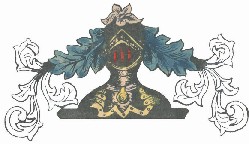


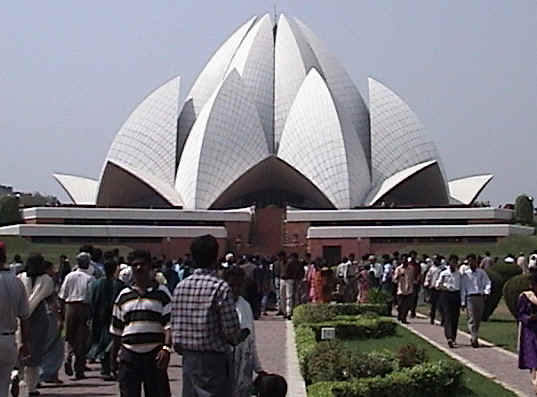
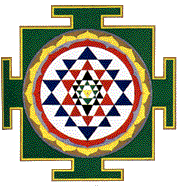 Because
it integrates a variety of heterogeneous elements, Hinduism
constitutes a complex but largely continuous whole; and, because it
covers the whole of life, it has religious, social, economic, literary,
and artistic aspects. Hinduism thus resists a precise definition, but
a common core of characteristics most Hindus share can be identified. Hinduism
is a religion with various Gods and Goddesses. According to Hinduism,
three Gods rule the world. Brahma: the creator; Vishnu: the preserver
and Shiva: the destroyer. These three Lords have consorts and they are
goddesses too. Consort of Brahma is Sarasvati; goddess of learning.
Vishnu's consort is Lakshmi; goddess of wealth and prosperity. Shiva's
consort is Parvati who is worshipped as Kali or Durga. Besides
these there are a number of other Gods and Goddesses. To name a few,
there is Ganesh, who has an elephant's head and he is also a son of
Shiva and Parvati; Hanuman, who is an ape; Surya Lord of sun; Ganga
Ma, Goddess of river Ganges; Samundra, Lord of the sea; Indra, king of
the Gods; Prithvi, Goddess of earth;
Because
it integrates a variety of heterogeneous elements, Hinduism
constitutes a complex but largely continuous whole; and, because it
covers the whole of life, it has religious, social, economic, literary,
and artistic aspects. Hinduism thus resists a precise definition, but
a common core of characteristics most Hindus share can be identified. Hinduism
is a religion with various Gods and Goddesses. According to Hinduism,
three Gods rule the world. Brahma: the creator; Vishnu: the preserver
and Shiva: the destroyer. These three Lords have consorts and they are
goddesses too. Consort of Brahma is Sarasvati; goddess of learning.
Vishnu's consort is Lakshmi; goddess of wealth and prosperity. Shiva's
consort is Parvati who is worshipped as Kali or Durga. Besides
these there are a number of other Gods and Goddesses. To name a few,
there is Ganesh, who has an elephant's head and he is also a son of
Shiva and Parvati; Hanuman, who is an ape; Surya Lord of sun; Ganga
Ma, Goddess of river Ganges; Samundra, Lord of the sea; Indra, king of
the Gods; Prithvi, Goddess of earth; 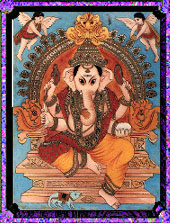 Shakti, Goddess of strength.
Some gods have more than
one name. Shiva is also known as Shankar, Mahadev, Natraj, Mahesh
amongst others. His worshippers also worship images of bull called
Nandi, who was Shiva's carrier and a unique stone design connected to
Shiva called the Shiva-Lingham. Ganesh is also called Ganpati. Lord
Vishnu went about preserving the world by incarnating 10 times in
human forms in times of crisis, and in his every appearance he had a
different form which are also worshipped as Gods. Among his
appearances, he appeared as Rama, Krishna, Narsimha, Parsuram and
Buddha. Krishna also has different names, Gopal; Kishan; Shyam and
other names. There are also Gods who can change their forms, such as
Parvati who can change into Kali or Durga. Not
all of these Gods are worshipped by all Hindus, with some Hindus
worshipping specific Gods or Goddesses, and some of these have
predominance in some regions. Hindus also worship Gods according to
their personal needs; those engaged in wrestling, body building and
other physical sports worship Hanuman, who in Hindu legends was an ape
with lot of physical strength; and those in business worship Lakshmi,
Goddess of wealth. Though
these Hindus worship different idols, there are many Hindus who
believe in one God and perceive in these different Gods and Goddesses
as different images of the same one God. According to their beliefs,
idolatry is the wrong interpretation of Hinduism. A
unique and all-encompassing
Shakti, Goddess of strength.
Some gods have more than
one name. Shiva is also known as Shankar, Mahadev, Natraj, Mahesh
amongst others. His worshippers also worship images of bull called
Nandi, who was Shiva's carrier and a unique stone design connected to
Shiva called the Shiva-Lingham. Ganesh is also called Ganpati. Lord
Vishnu went about preserving the world by incarnating 10 times in
human forms in times of crisis, and in his every appearance he had a
different form which are also worshipped as Gods. Among his
appearances, he appeared as Rama, Krishna, Narsimha, Parsuram and
Buddha. Krishna also has different names, Gopal; Kishan; Shyam and
other names. There are also Gods who can change their forms, such as
Parvati who can change into Kali or Durga. Not
all of these Gods are worshipped by all Hindus, with some Hindus
worshipping specific Gods or Goddesses, and some of these have
predominance in some regions. Hindus also worship Gods according to
their personal needs; those engaged in wrestling, body building and
other physical sports worship Hanuman, who in Hindu legends was an ape
with lot of physical strength; and those in business worship Lakshmi,
Goddess of wealth. Though
these Hindus worship different idols, there are many Hindus who
believe in one God and perceive in these different Gods and Goddesses
as different images of the same one God. According to their beliefs,
idolatry is the wrong interpretation of Hinduism. A
unique and all-encompassing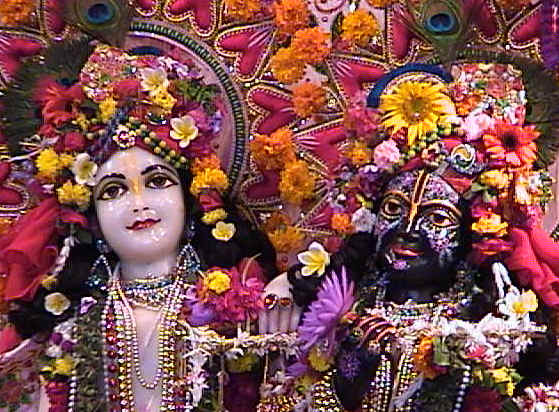 characteristic of Hinduism is that one
devotee may be worshipping Ganesha while a friend worships Siva or
Vishnu or Kali, yet both honor the other's choice and feel no sense of
conflict. The Hindu religion brings us the gift of tolerance that
allows for different stages of worship, different and personal
expressions of devotion and even different Gods to guide our life on
this earth. You will thus find Hindu temples for different Gods and
Goddesses in near proximity to each other. Indeed, you will find
places of worship for many different faiths in close proximity to each
other. About 80% of the population are Hindus, thus by far the most
common religion in India.
characteristic of Hinduism is that one
devotee may be worshipping Ganesha while a friend worships Siva or
Vishnu or Kali, yet both honor the other's choice and feel no sense of
conflict. The Hindu religion brings us the gift of tolerance that
allows for different stages of worship, different and personal
expressions of devotion and even different Gods to guide our life on
this earth. You will thus find Hindu temples for different Gods and
Goddesses in near proximity to each other. Indeed, you will find
places of worship for many different faiths in close proximity to each
other. About 80% of the population are Hindus, thus by far the most
common religion in India.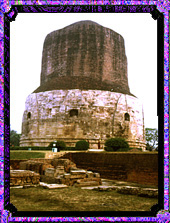 After the destruction of numerous
Buddhist monasteries in the 6th century AD by the Huns, Buddhism
revived, especially in the northeast, where it flourished for a time
under the Buddhist Pala kings (8th-12th century AD). With the collapse
of the Pala dynasty in the 12th century, Buddhism suffered another
defeat, and this time it did not recover.Scholars do not know all the
factors that contributed to the demise of Buddhism in its original
homeland. Some have maintained that Buddhism was so tolerant of other
faiths that it was simply reabsorbed by a revitalized Hindu tradition.
However, there was another factor that was very important as well:
Buddhism in India, having become mainly a monastic movement, probably
paid little heed to the laity. Some monasteries became wealthy enough
to have slaves and hired laborers to care for the monks and tend the
lands they owned. Thus, after the Muslim invaders sacked the Indian
monasteries in the 12th century AD, Buddhists had little basis for
recovery. After the destruction of the monasteries, the Buddhist laity
showed little interest in restoring the "Way", and now
number about 0.7% of India's population.
After the destruction of numerous
Buddhist monasteries in the 6th century AD by the Huns, Buddhism
revived, especially in the northeast, where it flourished for a time
under the Buddhist Pala kings (8th-12th century AD). With the collapse
of the Pala dynasty in the 12th century, Buddhism suffered another
defeat, and this time it did not recover.Scholars do not know all the
factors that contributed to the demise of Buddhism in its original
homeland. Some have maintained that Buddhism was so tolerant of other
faiths that it was simply reabsorbed by a revitalized Hindu tradition.
However, there was another factor that was very important as well:
Buddhism in India, having become mainly a monastic movement, probably
paid little heed to the laity. Some monasteries became wealthy enough
to have slaves and hired laborers to care for the monks and tend the
lands they owned. Thus, after the Muslim invaders sacked the Indian
monasteries in the 12th century AD, Buddhists had little basis for
recovery. After the destruction of the monasteries, the Buddhist laity
showed little interest in restoring the "Way", and now
number about 0.7% of India's population. That they should add "Singh" (lion)
to their name and be baptized by taking "Amrit" (holy, or
"communion" water). Further, he gave them a uniform
consisting of five "Ks": (1) Kesh (uncut hair) to represent
a complete natural person as made by God, thus showing non-attachment
to vanity, (2) Kanga, a comb to keep the hair tidy, (3) Kachha (underpants)
rather than the loose "dhoti" (a type of a sarong for males)
worn by all at that time to signify an active person who had
self-control and continence, (4) Kirpan (a short sword) to symbolize
freedom from oppression, but useful for self defense or to defend the
weak, and, (5) Kara (a steel bangle) to signify a strong and
unbreakable link to the religion, together with continuity of life,
without beginning, without end, and an awareness of immortality and of
timelessness.About 2% of India's population are Sikhs, and yet play an
important role in the defense forces (with thirty percent of it made
up by the Sikhs), agriculture and commerce.
That they should add "Singh" (lion)
to their name and be baptized by taking "Amrit" (holy, or
"communion" water). Further, he gave them a uniform
consisting of five "Ks": (1) Kesh (uncut hair) to represent
a complete natural person as made by God, thus showing non-attachment
to vanity, (2) Kanga, a comb to keep the hair tidy, (3) Kachha (underpants)
rather than the loose "dhoti" (a type of a sarong for males)
worn by all at that time to signify an active person who had
self-control and continence, (4) Kirpan (a short sword) to symbolize
freedom from oppression, but useful for self defense or to defend the
weak, and, (5) Kara (a steel bangle) to signify a strong and
unbreakable link to the religion, together with continuity of life,
without beginning, without end, and an awareness of immortality and of
timelessness.About 2% of India's population are Sikhs, and yet play an
important role in the defense forces (with thirty percent of it made
up by the Sikhs), agriculture and commerce. 